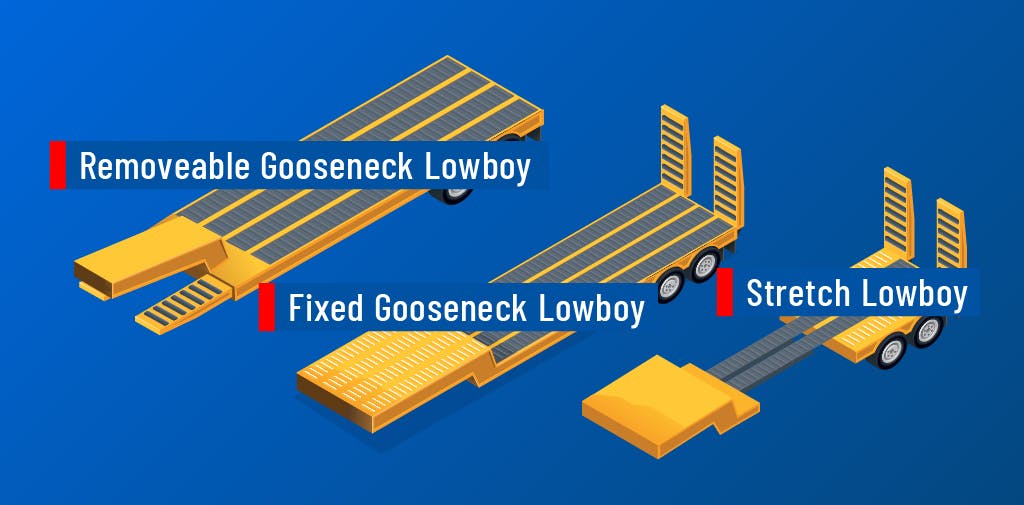Complete Guide to Lowboy Trailers
March 27th, 2023

Trailers are not one-size-fits-all. You must use the proper trailer while transporting certain goods or machinery. There are different sorts of trailers navigating these roads to safely get items from one place to another in the best condition. Various trailer types are designed to serve specific functions. Still not sure if a lowboy trailer is best for your hauling needs? Here’s a guide on our lowboy trailers for sale and everything you should know about them.
What is a Lowboy Trailer?
A common question many ask is, “What is a lowboy truck?”This is a type of trailer that you’ve probably seen hauling construction equipment and industrial machines. They are one of the most adaptable as a semi-trailer with a drop-neck.
A lowboy is sometimes referred to as a double drop trailer. It consists of a front neck, which may be fixed or removable, a deck, and a set of rear axles. The important feature of a lowboy is that it is very low to the ground for maximum payload height, and the deck sits below the height of the trailer’s tires, marking the second “drop,” with the other being at the neck.
What are Lowboy Trailers Used For?
Lowboy trailers are frequently utilized to transport heavy or oversize items. Lowboy trailers are ideal for transporting bulldozers, cars, and other large equipment or freight. Basically, anything that won’t fit on a flatbed or single-drop trailer. Because lowboy trailers are used to transport such huge and oversized cargo, extra safety precautions must be followed when operating them.
The Importance of Lowboy Trailers in the Transportation Industry
Lowboy trailers are a perfect solution for tall or oversized freight. In other words, lowboy trucks provide trustworthy businesses with another option for better serving customers. When big or heavy freight needs to be shipped, the lowboy trailers apart of your fleet can assist.
The main purpose of a lowboy is to make it easier for drivers to load and unload their cargo. Lowboys offer more stability while you’re loading it up so that there is less risk of tipping over while you work on getting everything ready for transport.
Types of Lowboy Trailers

There are some main lowboy trailers to be aware of: fixed gooseneck lowboys, removable gooseneck lowboys, and stretch lowboy trailers, or even schnables. Let’s go through each one in more depth to give you a grasp of the styles of lowboy trailers:
Fixed Gooseneck Lowboy Trailer
The fixed gooseneck lowboy trailer (FGN) has a larger deck length and is lightweight. Because it is a lowboy, a FGN is low to the earth and usually includes drop ramps in the back for quick and easy equipment loading.
Removable Gooseneck Lowboy Trailer
This trailer, also known as an RGN, has a shorter deck length. Not to be confused with a RGN, the difference between lowboy and RGN are essentially an RGN is a kind of lowboy. So, the capacity of the trailers is what separates them.
Thanks to a hydraulic mechanism that can raise and lower the trailer on demand, the gooseneck may be swiftly and easily withdrawn. An RGN is perfect for driving, rolling, pulling, or pushing equipment onto a trailer bed.
Stretch Lowboy Trailers
A stretch double drop trailer is intended for oversized freight that is too long for a conventional step deck trailer due to length regulations. It also acts as a brace, preventing overhang. Loads up to 10 feet in height are permitted on the lower deck. The trainer is designed with a longer component, or well, at the back deck and middle areas of the trailer, often measuring 25 to 29 feet.
Pros and Cons of Using a Lowboy Trailer
While we’ve briefly discussed some of the types of lowboys and their functions, there are countless other reasons to consider using a lowboy trailer for your next haul.
Advantages
Advantages of lowboy trailers include:
- Stability: By their lower center of gravity, lowboy trailers are more stable than other trailers. This is because they used to moving equipment without violating height limitations.
- Versatile: Low-bed trailers have a wide range of applications. The low-bed semi-trailer was originally designed to transport the heaviest weight without violating safety standards or placing the driver or cargo in danger.
- Longevity: These trailers are very durable and designed to last for many years without needing any major repairs or maintenance work done on them regularly. Some other types, depending on what they are made out of, need more repairs so they don’t break down while driving or while loading/unloading the trailer.
Disadvantages
Disadvantages of lowboy trailers include:
- Investment Cost: The initial investment of buying a lowboy can be a lot upfront, even used lowboys. The routine maintenance may be far between but they are costly.
- Freight Limitations: Due to weather conditions, a lowboy may not be best to ships electronics, home furnishing, or perishable items. There may also be a need to keep the temperature of the cargo regulated which you don’t get with a lowboy.
- Skill Difficulty: Transporting big loads necessitates special handling and hauling abilities. Even securing the load can be hazardous when connecting straps and chains onto the load.
Is a Lowboy Trailer Right for Me?
Lowboy trailers are typically used in industries like shipping and construction, where they’re needed to transport very heavy and tall loads over long distances. So, if you’ve been thinking about getting a lowboy trailer for your business, ask yourself before making a purchase:
- Will my company need to haul heavy loads? If so, how often will we need to do so?
- How much room do we have in our vehicle fleet? Do any of our trucks have the right kind of hitch to pull a lowboy trailer?
- How much money do we have set aside for new equipment purchases? Would it be better to work with lowboy trailer rentals instead of buying one outright?
If you answered yes to most of these questions, a lowboy trailer might be the right choice for you.
Frequently Asked Questions
How Much do Lowboy Trailers Weigh?
The weight of a lowboy trailer can vary depending on the manufacturer, model, and carrying capacity. A lightweight, 35 ton lowboy may weigh in the 15,000-18,000. Trailers designed for oversized loads can approach 40,000 pounds.
How Long is a Lowboy Trailer?
The length of a lowboy trailer can vary, but it typically 53 feet. Additional axles may add additional length. Often, it is the length of the well which is more important, which is typically 24 to 26 feet. Some models may go up to 29’6″.
Haul More with Hale Trailer
If you need to transfer large cargo and equipment, consider diversifying your inventory of transportation solutions. Hale Trailer offers a variety of lowboy trailers for sale that can be used to transport what you need.
Hale Trailer has the expertise to connect you with trailer options that are ideal for your next haul. The next addition to your fleet can be selected from our line-up of trailers ready for the road available to you for purchase or rent. Our selection can be found online or stop by one of our locations to learn more about how we can work for you.
All the information on this website – https://www.haletrailer.com – is published in good faith and for general information purposes only. Hale Trailer Brake and Wheel does not make any warranties about the completeness, reliability and accuracy of this information. Any action you take upon the information you find on this website, is strictly at your own risk. Hale Trailer Brake and Wheel will not be liable for any losses and/or damages in connection with the use of our website.
